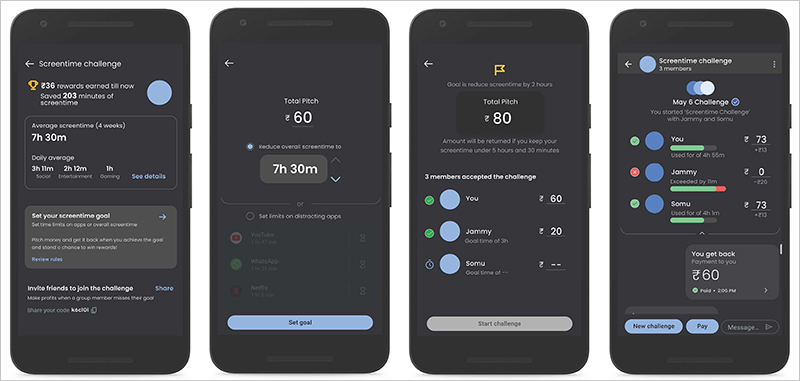References
- Alberto Monge Roffarello and Luigi De Russis. 2021. Designing technology that promotes users’ digital wellbeing. XRDS 28, 1 (Fall 2021), 14–18.
DOI: https://doi.org/10.1145/3481823
- Alberto Monge Roffarello and Luigi De Russis. 2021. Coping with Digital Wellbeing in a Multi-Device World. In Proceedings of the 2021 CHI Conference on Human Factors in Computing Systems (CHI ‘21). Association for Computing Machinery, New York, NY, USA, Article 538, 1–14. DOI: https://doi.org/10.1145/3411764.3445076
- Alexander Serenko and Ofir Turel. 2020. Directing Technology Addiction Research in Information Systems: Part I. Understanding Behavioral Addictions. SIGMIS Database 51, 3 (August 2020), 81–96. DOI: https://doi.org/10.1145/3410977.3410982
- Alberto Monge Roffarello and Luigi De Russis. 2019. The Race Towards Digital Wellbeing: Issues and Opportunities. Proceedings of the 2019 CHI Conference on Human Factors in Computing Systems. Association for Computing Machinery, New York, NY, USA, Paper 386, 1–14. DOI: https://doi.org/10.1145/3290605.3300616
- Wendel, S. (2020). Designing for behavior change: Applying psychology and behavioral economics. O’Reilly Media.
- Sara Lunder, Kate Lockhart, and Lauren Wilcox, Google Design, 2021, https://design.google/library/designing-for-digital-wellbeing/
- Charlie Pinder, Jo Vermeulen, Benjamin R. Cowan, and Russell Beale. 2018. Digital Behaviour Change Interventions to Break and Form Habits. ACM Trans. Comput.-Hum. Interact. 25, 3, Article 15 (June 2018), 66 pages. https://doi.org/10.1145/3196830
- Biedermann, D., Schneider, J., & Drachsler, H. (2021). Digital self‐control interventions for distracting media multitasking‐A systematic review. Journal of Computer Assisted Learning, 37(5), 1217-1231.
- Ploderer, B., Reitberger, W., Oinas-Kukkonen, H., & van Gemert-Pijnen, J. (2014). Social interaction and reflection for behaviour change. Personal and ubiquitous computing, 18(7), 1667-1676.
- Aranda, J. H., & Baig, S. (2018, September). Toward” JOMO” the joy of missing out and the freedom of disconnecting. In Proceedings of the 20th international conference on human-computer interaction with mobile devices and services (pp. 1-8).
- Schmitt, J. B., Breuer, J., & Wulf, T. (2021). From cognitive overload to digital detox: Psychological implications of telework during the COVID-19 pandemic. Computers in human behavior, 124, 106899.
- Serenko, A., & Turel, O. (2020). Directing technology addiction research in information systems: Part I. Understanding behavioral addictions. ACM SIGMIS Database: the DATABASE for Advances in Information Systems, 51(3), 81-96.
- Lanette, S., Chua, P. K., Hayes, G., & Mazmanian, M. (2018). How much is’ too much’? The role of a smartphone addiction narrative in individuals’ experience of use. Proceedings of the ACM on Human-Computer Interaction, 2(CSCW), 1-22.
- Hagura, N., Haggard, P., & Diedrichsen, J. (2017). Perceptual decisions are biased by the cost to act. Elife, 6
- Das, K.V., Jones-Harrell, C., Fan, Y. et al. Understanding subjective well-being: perspectives from psychology and public health. Public Health Rev 41, 25 (2020). https://doi.org/10.1186/s40985-020-00142-5
- Diener, E., Lucas, R. E., & Oishi, S. (2002). Subjective well-being: The science of happiness and life satisfaction. In C. R. Snyder & S. J. Lopez (Eds.), Handbook of positive psychology (pp. 63–73). New York: Oxford University Press.
- Seligman, M. E., & Csikszentmihalyi, M. (2000). Positive psychology: An introduction (Vol. 55, No. 1, p. 5). American Psychological Association.
- Fogg, B. J. (2019). Fogg’s Behavior Model. Behav. Des. Lab., Stanford Univ., Stanford, CA, USA, Tech. Rep.
- A. Alutaybi, E. Arden-Close, J. McAlaney, A. Stefanidis, K. Phalp and R. Ali, “How Can Social Networks Design Trigger Fear of Missing Out?,” 2019 IEEE International Conference on Systems, Man and Cybernetics (SMC), 2019, pp. 3758-3765, doi: 10.1109/SMC.2019.8914672.
- Minsam Ko, Kyong-Mee Chung, Subin Yang, Joonwon Lee, Christian Heizmann, Jinyoung Jeong, Uichin Lee, Daehee Shin, Koji Yatani, and Junehwa Song. 2015. NUGU: A Group-based Intervention App for Improving Self-Regulation of Limiting Smartphone Use. Proceedings of the 18th ACM Conference on Computer Supported Cooperative Work & Social Computing - CSCW ’15 (2015), 1235–1245.
https://doi.org/
- Aarathi Prasad, Lucas S. LaFreniere, Vaasu Taneja, and Zoe Beals. 2021. Addressing Problematic Smartphone Use with a Personalized, Goal-based Approach. In Adjunct Proceedings of the 2021 ACM International Joint Conference on Pervasive and Ubiquitous
- Computing and Proceedings of the 2021 ACM International Symposium on Wearable Computers (UbiComp-ISWC ’21 Adjunct), September 21–26, 2021, Virtual, USA. ACM, New York, NY, USA, 4 pages. https://doi.org/10.1145/3460418.3479319
- Katarina Jurczyk, Christopher You, Mahsan Nourani, Manas Gupta, Lisa Anthony, and Benjamin Lok. 2021. Romadoro: Leveraging Nudge Techniques to Encourage Break-Taking. In The Adjunct Publication of the 34th Annual ACM Symposium on User Interface Software and Technology (UIST ’21 Adjunct), October 10–14, 2021, Virtual Event, USA. ACM, New York, NY, USA, 4 pages. https://doi.org/10.1145/3474349.3480231
- Ko, M., Yang, S., Lee, J., Heizmann, C., Jeong, J., Lee, U., ... & Chung, K. M. (2015, February). NUGU: A group-based intervention app for improving self-regulation of limiting smartphone use. In Proceedings of the 18th ACM conference on computer supported cooperative work & social computing (pp. 1235-1245).
- Minsam Ko, Seungwoo Choi, Koji Yatani, and Uichin Lee. 2016. Lock N’ LoL: Group-based Limiting Assistance App to Mitigate Smartphone Distractions in Group Activities. In Proceedings of the 2016 CHI Conference on Human Factors in Computing Systems. ACM, New York, 998–1010. https://doi.org/10.1145/2858036.2858568
- Fabian Okeke, Michael Sobolev, Nicola Dell, and Deborah Estrin. 2018. Good vibrations: can a digital nudge reduce digital overload? In Proceedings of the 20th International Conference on Human-Computer Interaction with Mobile Devices and Services (MobileHCI ‘18). Association for Computing Machinery, New York, NY, USA, Article 4, 1–12. DOI: https://doi.org/10.1145/3229434.3229463
- Jaejeung Kim, Chiwoo Cho, and Uichin Lee. 2017. Technology Supported Behavior Restriction for Mitigating Self-Interruptions in Multi-device Environments. Proc. ACM Interact. Mob. Wearable Ubiquitous Technol. 1, 3, Article 64 (September 2017), 21 pages.
DOI: https://doi.org/10.1145/3130932
- Yuhan Luo, Bongshin Lee, Donghee Yvette Wohn, Amanda L. Rebar, David E. Conroy, and Eun Kyoung Choe. 2018. Time for Break: Understanding Information Workers’ Sedentary Behavior Through a Break Prompting System. Proceedings of the 2018 CHI Conference on Human Factors in Computing Systems. Association for Computing Machinery, New York, NY, USA, Paper 127, 1–14.
DOI: https://doi.org/10.1145/3173574.3173701
- Inyeop Kim, Gyuwon Jung, Hayoung Jung, Minsam Ko, and Uichin Lee. 2017. Let’s FOCUS: Mitigating Mobile Phone Use in College Classrooms. Proc. ACM Interact. Mob. Wearable Ubiquitous Technol. 1, 3, Article 63 (September 2017), 29 pages.
DOI: https://doi.org/10.1145/3130928
- Jee Bin Yim, Donghyeon Ko, andWoohun Lee. 2021. Romi: Screen Peripheral Companion for Mediating Children’s Healthy Screen Use. In Interaction Design and Children (IDC ’21), June 24–30, 2021, Athens, Greece. ACM, New York, NY, USA, 5 pages. https://doi.org/10.1145/3459990.3465179
- Carels, R. A., Young, K. M., Koball, A., Gumble, A., Darby, L. A., Wagner Oehlhof, M., ... & Hinman, N. (2011). Transforming your life: An environmental modification approach to weight loss. Journal of health psychology, 16(3), 430-438.
- White, I., Smith, L., Aggio, D., Shankar, S., Begum, S., Matei, R., ... & Gardner, B. (2017). On Your Feet to Earn Your Seat: pilot RCT of a theory-based sedentary behaviour reduction intervention for older adults. Pilot and feasibility studies, 3(1), 1-14.
- Purohit, A. K., Barclay, L., & Holzer, A. (2020, April). Designing for digital detox: Making social media less addictive with digital nudges. In Extended Abstracts of the 2020 CHI Conference on Human Factors in Computing Systems (pp. 1-9).
- Adaji, I., Vassileva, J. (2016). Persuasive Patterns in Q&A Social Networks. In: Meschtscherjakov, A., De Ruyter, B., Fuchsberger, V., Murer, M., Tscheligi, M. (eds) Persuasive Technology. PERSUASIVE 2016. Lecture Notes in Computer Science(), vol 9638. Springer, Cham. https://doi.org/10.1007/978-3-319-31510-2_16
- American Psychiatric Association. 2013. DSM 5. American Psychiatric Association.
- Kwon M., Lee J. Y., Won W. Y., Park J. W., Min J. A., Hahn C., et al. (2013b). Development and validation of a smartphone addiction scale (SAS). PLoS One 8:e56936. 10.1371/journal.pone.0056936
- Dongil Kim, Yunhee Lee, Juyoung Lee, JeeEun Karin Nam, and Yeoju Chung. 2014. Development of Korean smartphone addiction proneness scale for youth. PloS one 9, 5: 1-8.
- Lanette, S., & Mazmanian, M. (2018, April). The Smartphone" Addiction" Narrative is Compelling, but Largely Unfounded. In Extended Abstracts of the 2018 CHI Conference on Human Factors in Computing Systems (pp. 1-6)
- Harris, B., Regan, T., Schueler, J., & Fields, S. A. (2020). Problematic mobile phone and smartphone use scales: A systematic review. Frontiers in Psychology, 11, 672.
- Serenko, A., & Turel, O. (2020). Directing technology addiction research in information systems: Part I. Understanding behavioral addictions. ACM SIGMIS Database: the DATABASE for Advances in Information Systems, 51(3), 81-96.
Other Links:
Case Study Download:
• Exploring Digital Wellbeing Strategies......


